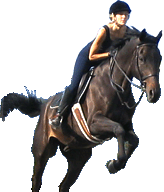|
The predecessor to eventing originally began as a form of endurance
riding, without jumping or galloping. Originally developed to test
the ideal military mount, eventing has evolved into a sport in which
all levels of riders can compete.
There are four levels of competition in Eventing, designated by
stars. The levels are indicated by one star through four stars.
Four stars is the highest level of competition, and 4 stars is the
same level of competition as Olympic Eventing.
Since the inception of the sport of Eventing, British bred event
horses have been acknowledged and rewarded as the best in the world.
This is due to the fact that few horses have been specifically bred
for eventing. Furthermore eventing is a low priority in European
breeding programs accounting for only about 3% of the equestrian
sports.
Three-day eventing consists of three elements: dressage, endurance
and show jumping. Three-day eventing consists of one day each of
dressage, show jumping, and one of cross-country riding. This places
extreme demands on the horse's muscoskelatal system. The efforts
of both the training program and the competition are rigorous. Eventing
horses are athletes and need to be obedient, intelligent and bold
with obvious strength and soundness.
At the higher levels of eventing, each horse must pass veterinarian
inspection before and after completion of the course. Such information
is essential to inform other injury prevention projects and to develop
counter measures to reduce falls and injuries during eventing.
The simplest form of eventing, horse trials, is a one-day event.
It is a good starting point for most competitors. At the lower levels
of Eventing, basic level dressage tests are used and fences are
smaller and inviting. It is especially beneficial for beginners
interested in trying eventing but are unsure if it is a fit for
themselves or their horse.
Eventing is one of the most dangerous equestrian activities. Though
eventing competitors take great pains to carefully prepare and train
their horses for all eventualities, accidents or mistakes can happen.
Improved protective equipment, which was made mandatory in 1999,
have reduced the severity of head and facial injuries in eventing.
About the Author
Rob Daniels has been an equestrian rider for 25 years. He has studied
various disciplines additional articles are available at: Riding
Stable - http://www.riding-stable.com
and Horse Stall http://www.horse-stall.net
|


